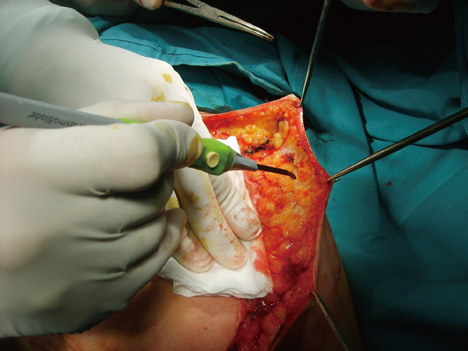J Breast Cancer.
2013 Jun;16(2):198-201. 10.4048/jbc.2013.16.2.198.
The Effect of Plasmakinetic Cautery on Wound Healing and Complications in Mastectomy
- Affiliations
-
- 1Department of General Surgery, Ankara Oncology Training and Education Hospital, Ankara, Turkey. lutfidogan1@yahoo.com
- KMID: 2286401
- DOI: http://doi.org/10.4048/jbc.2013.16.2.198
Abstract
- PURPOSE
Surgical equipment used in breast cancer surgery that affects wound healing and minimizes complications seems to be a popular investigation topic. The aim of this study is to evaluate the effect of plasmakinetic cautery on wound healing in patients receiving mastectomy.
METHODS
Forty-six consecutive breast cancer patients receiving modified radical mastectomy were evaluated prospectively. Plasmakinetic cautery was used in 24 operations and electrocautery was used in 22 operations in random order to manage skin flaps and excise breast tissue. In the postoperative period, vacuum drainage amount and duration time as well as the start time of arm exercises were recorded. Complications like seroma, surgical site infection, hematoma, and flap necrosis were determined.
RESULTS
Age, body mass index, breast volume and flap area parameters were similar in each group. Mean drainage duration was found to be 5.5 days in the plasmacautery group and 7.9 days in the electrocautery group (p=0.020). In the plasmacautery and electrocautery groups, mean drainage volume was 707 and 1,093 mL, respectively (p=0.025). There was no statistical significance between the groups when operation duration, amount of blood loss, time to start arm exercises, seroma, hematoma, surgical site infection, and flap necrosis were considered.
CONCLUSION
Plasmakinetic cautery is a promising new surgical instrument that provides atraumatic, scalpel-like cutting precision and electrosurgical-like hemostasis, resulting in minimal tissue injury. So, plasmacautery shortens the drainage amount and duration time compared to electrocautery without elongating operation duration or increasing the amount of blood loss.
MeSH Terms
Figure
Cited by 1 articles
-
Wound healing and postsurgical complications in breast cancer surgery: a comparison between PEAK PlasmaBlade and conventional electrosurgery – a preliminary report of a case series
Corrado Chiappa, Anna Fachinetti, Carlo Boeri, Veronica Arlant, Stefano Rausei, Gianlorenzo Dionigi, Francesca Rovera
Ann Surg Treat Res. 2018;95(3):129-134. doi: 10.4174/astr.2018.95.3.129.
Reference
-
1. Loh SA, Carlson GA, Chang EI, Huang E, Palanker D, Gurtner GC. Comparative healing of surgical incisions created by the PEAK PlasmaBlade, conventional electrosurgery, and a scalpel. Plast Reconstr Surg. 2009; 124:1849–1859.
Article2. Ruidiaz ME, Messmer D, Atmodjo DY, Vose JG, Huang EJ, Kummel AC, et al. Comparative healing of human cutaneous surgical incisions created by the PEAK PlasmaBlade, conventional electrosurgery, and a standard scalpel. Plast Reconstr Surg. 2011; 128:104–111.
Article3. Pogson CJ, Adwani A, Ebbs SR. Seroma following breast cancer surgery. Eur J Surg Oncol. 2003; 29:711–717.
Article4. Kuroi K, Shimozuma K, Taguchi T, Imai H, Yamashiro H, Ohsumi S, et al. Pathophysiology of seroma in breast cancer. Breast Cancer. 2005; 12:288–293.
Article5. Lumachi F, Brandes AA, Burelli P, Basso SM, Iacobone M, Ermani M. Seroma prevention following axillary dissection in patients with breast cancer by using ultrasound scissors: a prospective clinical study. Eur J Surg Oncol. 2004; 30:526–530.
Article6. Yilmaz KB, Dogan L, Nalbant H, Akinci M, Karaman N, Ozaslan C, et al. Comparing scalpel, electrocautery and ultrasonic dissector effects: the impact on wound complications and pro-inflammatory cytokine levels in wound fluid from mastectomy patients. J Breast Cancer. 2011; 14:58–63.
Article7. Miller E, Paull DE, Morrissey K, Cortese A, Nowak E. Scalpel versus electrocautery in modified radical mastectomy. Am Surg. 1988; 54:284–286.8. Hoefer RA Jr, DuBois JJ, Ostrow LB, Silver LF. Wound complications following modified radical mastectomy: an analysis of perioperative factors. J Am Osteopath Assoc. 1990; 90:47–53.
Article9. Stevens WG, Gear AJ, Stoker DA, Hirsch EM, Cohen R, Spring M, et al. Outpatient reduction mammaplasty: an eleven-year experience. Aesthet Surg J. 2008; 28:171–179.
Article10. Ruidiaz ME, Martin DT, Ta CN, Vose JG, Cortes-Mateos MJ, Wang-Rodriguez J, et al. A prospective controlled trial of the PEAK PlasmaBlade in the evaluation of breast cancer surgical specimens with touch prep. In : The 11th Annual Meeting of American Society of Breast Surgeons; 2010. Abstract #206.11. Sangoi A, Vose J, Atmodjo D, Naruns P. A randomized controlled trial of the PEAK PlasmaBlade in open breast biopsy compared to scalpel and traditional electrosurgery. In : The 11th Annual Meeting of American Society of Breast Surgeons; 2010. Abstract #209.
- Full Text Links
- Actions
-
Cited
- CITED
-
- Close
- Share
- Similar articles
-
- Nutritional Support and Wound Healing
- Deciphering the Role of Non-Coding RNAs as Regulators in the Wound Healing Process
- The Relationship between Rate of Wound Healing and Success Rate after Endonasal Laser-drill Assisted Dacryocystorhinostomy
- Homologous fibronectin enhances healing of excised wounds in rats
- Proliferation of Keratinocytes Induced by Adipose-Derived Stem Cells on a Chitosan Scaffold and Its Role in Wound Healing, a Review


